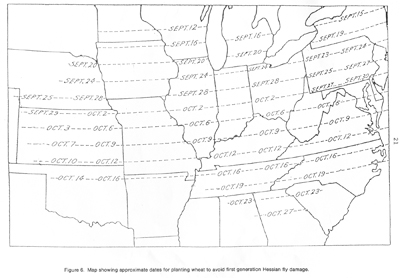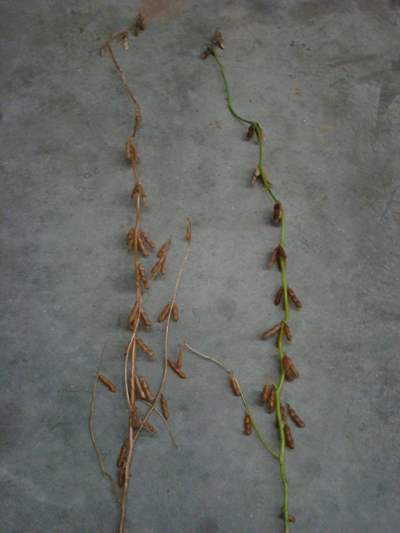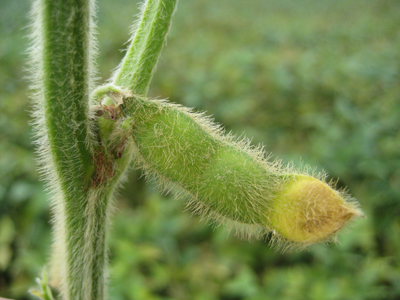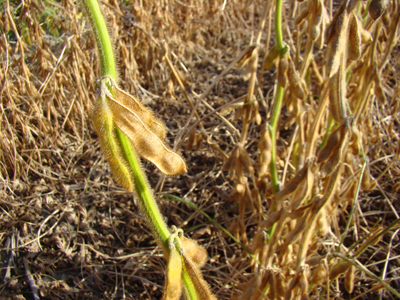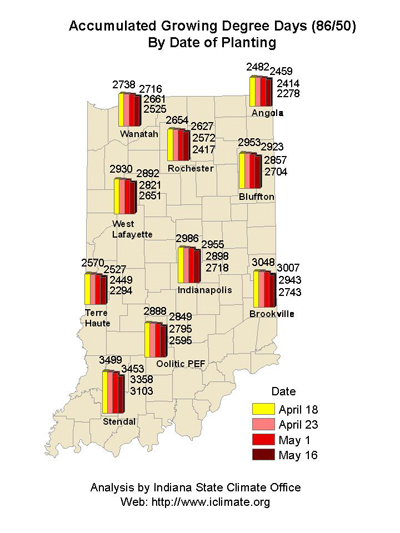Pest & Crop Newsletter, Entomology Extension, Purdue University
- Hessian Fly Still a Concern in Wheat Growing States
- VIDEO: Assessing WBC Damage to Field Corn
- Black Light Trap Catch Report
Hessian Fly Still a Concern in Wheat Growing States- (Brandi Schemerhorn & Sue Cambron
- Remember to utilize fly free dates.
- Destruction of volunteer wheat helps reduce insect reservoir to avoid spring infestations.
The Hessian fly is present in wheat growing areas throughout the US, including Indiana. The Hessian fly can survive on alternative grass hosts, and will be waiting for the next time wheat is planted in a given area. When the opportunity presents itself for a wheat infestation, there is potential for a rapid increase of fly populations as a result of weather conditions or cropping practices that favor survival of eggs and young larvae in the fall.
Following the fly-free date. A low fall infestation often goes unnoticed due to the tillering of the wheat plant. Much of the fall fly population can be avoided by planting after the fly-free date. The fly-free date is of key importance, even if you plan to use the wheat only for cattle. This fly-free date is our main protection to avoid a subsequent infestation by the spring brood. Additionally, it has been shown that following the fly-free date helps reduce other wheat disease problems and reduces winter-kill from excessive growth.
"Test plots showing resistance and susceptible wheat
Plowing fields after wheat harvest destroys the fly. The Hessian fly passes the summer in the stubble of the current wheat crop. Volunteer wheat germinates and begins growing just in time for the fall emergence of the Hessian fly. These plants are readily infested resulting in a rapid build-up of the population. Removal of volunteer wheat before the emergence of the fall brood greatly reduces the insect reservoir for a spring infestation.
Infestations in the mid-west were down this year, mainly due to adherence to the fly-free dates.
Map showing approximate dates for planting wheat to avoid first generation Hessian fly damage
![]()
Assessing WBC Damage to Field Corn - (Christian Krupke and John Obermeyer)
- Reports of WBC damage in northern counties, both in Bt and non-Bt hybrids.
- Slight damage may be apparent, even on Bt hybrids that control WBC.
- Gene-check strips will soon be essential equipment for pest managers.
Many pest managers are entering fields and checking the condition of the crop just prior to harvest. You’ve all read and heard about the widespread Western Bean Cutworm flights that we experienced here in Indiana, and the damage reports have begun to come in now. One thing to keep in mind when assessing damage is that knowing the traits expressed by the hybrid you are looking at will be key in assessing damage levels – for example, Bt hybrids that advertise “control” of a given pest should be held to a higher standard than those that do not, or non-Bt varieties. The video below demonstrates the use of protein test strips - a simple, effective tool for identifying the traits in individual plants in the field. These tools will become far more useful as the industry moves toward seed mix refuges (also called refuge in a bag) – there will be no other way to tell the refuge from transgenic plants in these mixed stands. The video below gives a brief overview of a quick and relatively inexpensive way to screen plants at any time during the season.
Watch the video on assessing WBC damage to field corn.
![]()
Click here to view the Black Light Trap Catch Report
Soybean harvest (7% as of September 12th) is about a week ahead of the five-year average (USDA-NASS, 2010). As I scout from the windshield many fields appear to be 7 to 10 days away from harvest due to the greenness of the stems. However, grain moisture is as low as 10% in many of those same fields. This scenario is a one-two punch to soybean producers. Today, we sell soybeans by weight (60-lb units at 13% moisture) and not by the volume (bushel) as in the past. Harvesting and selling soybeans at 10% moisture means that we are losing out on the opportunity to sell 3% water weight. The recommendation is to harvest soybeans at or slightly above 13% moisture to maximize yield, but green stems are tough to harvest. Two options exist for this scenario: (a) harvest at optimal grain moisture to capture water weight even with green stems that will likely slow harvest and potential increase fuel expense, or (b) harvest plants with brown stems for easier threshing at the loss of yield via water weight and potentially shattering in the coming weeks. There is no simple answer, but I will address the green-stem syndrome we are seeing in 2010.
Green-stem syndrome is where pods and seeds mature (turning harvest color and dry down) while the stems remain green (Figure 1). This is not the same as “stay-green,” which is where a plant retains the green color (chlorophyll) in the stems, leaves, and pods longer. Stay-green is often associated with varietal differences, fungicide applications, or growth regulator applications. Viral diseases, insect infestations, and environmental stresses during seed fill have been suggested as the sources of green-stem syndrome in soybean. A recent study proposes that the common link among these culprits is the effects on pod retention and seed fill (Egli and Bruening, 2006). They removed 25 and 50% of the pods at R6 (full seed) among varieties within maturity groups III, IV, and V in Kentucky. The pod removal minimally affected the rate of pod maturation, but stem maturation was delayed significantly (10 to 20 days and sometimes greater) with the greatest delay in the 50% pod removal treatments. In some cases, the stems did not mature before the first frost.
Figure 1. Two soybean plants growing side-by-side in the field. Plant on the left has mature pods and mature stem; whereas, the plant on the right has mature pods and green stem (green-stem syndrome)
Similarly, stressed-soybean plants “decide” which pods to retain and seeds to fill. A loss of pods and / or seeds reduces the demand for photoassimilates (sugars and nutrients) that are transported from the leaves (the supplier). The redistribution of photoassimilates is rapid during R5 (beginning of seed fill) and continues at a slower pace through R6 (full seed). High temperatures and limited rain in August stressed many soybeans during the critical seed fill period (and pod development with the late-planted soybeans). Many pods and seeds were aborted (Figure 2) during this photoassimilates in the leaves and the stems. Late-season bean leaf beetle feeding could also be stressing some soybeans across the state. Low humidity and relatively warm temperatures in September have also provided a situation for fast grain dry down in the field. However, the stem tissue is maintained with the “extra” supply of photoassimilates and retains the green color (Figure 1). Green-stem syndrome yield losses are usually related to the stresses that caused a reduction in demand (pod or seed loss, Figure 3). Delayed harvest often results in yield loss via grain moisture and shattering. We need to be aware that this phenomenon is occurring, so we can make informed decisions about optimizing harvest and reducing losses in yield and profit.
Figure 2. Soybean seed was aborted due to drought stress
Figure 3. Arrested seed fill (upper pods) contributed to the green stem even with mature pods
References:
Egli, D.B. and W.P. Bruening. 2006. Depodding causes green-stem syndrome in soybean. Online. Crop Management. <www.plantmanagementnetwork.org/pub/cm/research/2006/depodding/>.
USDA-NASS, 2010. Indiana crop & weather report as of September 12. Vol 60:WC091310.


